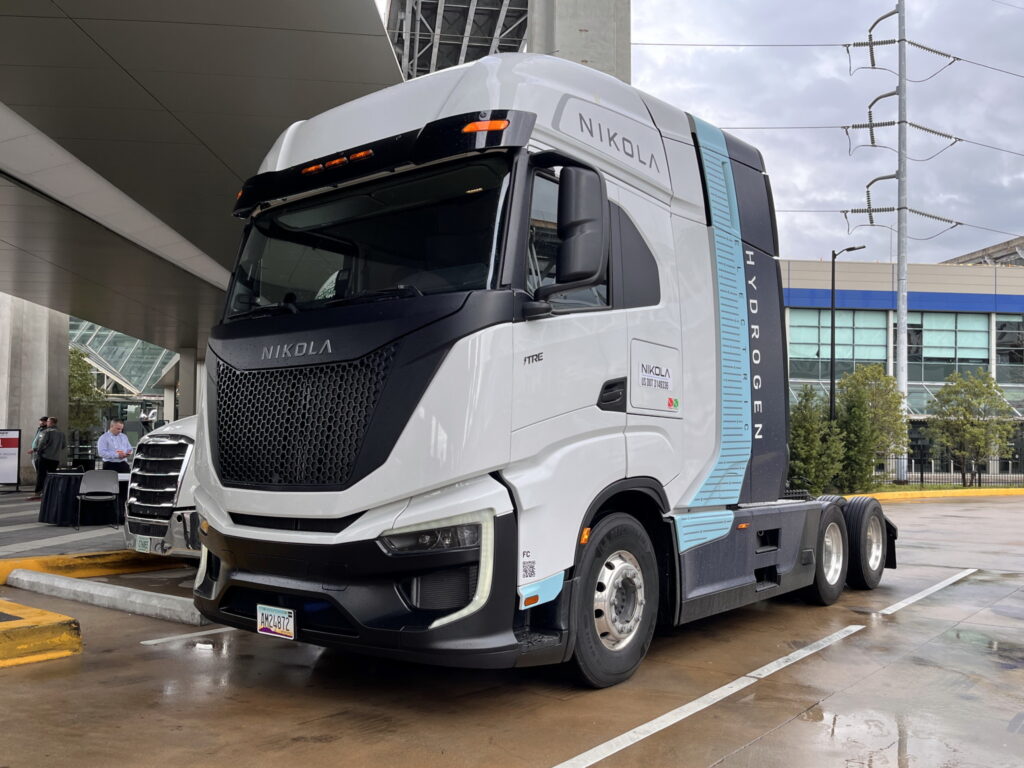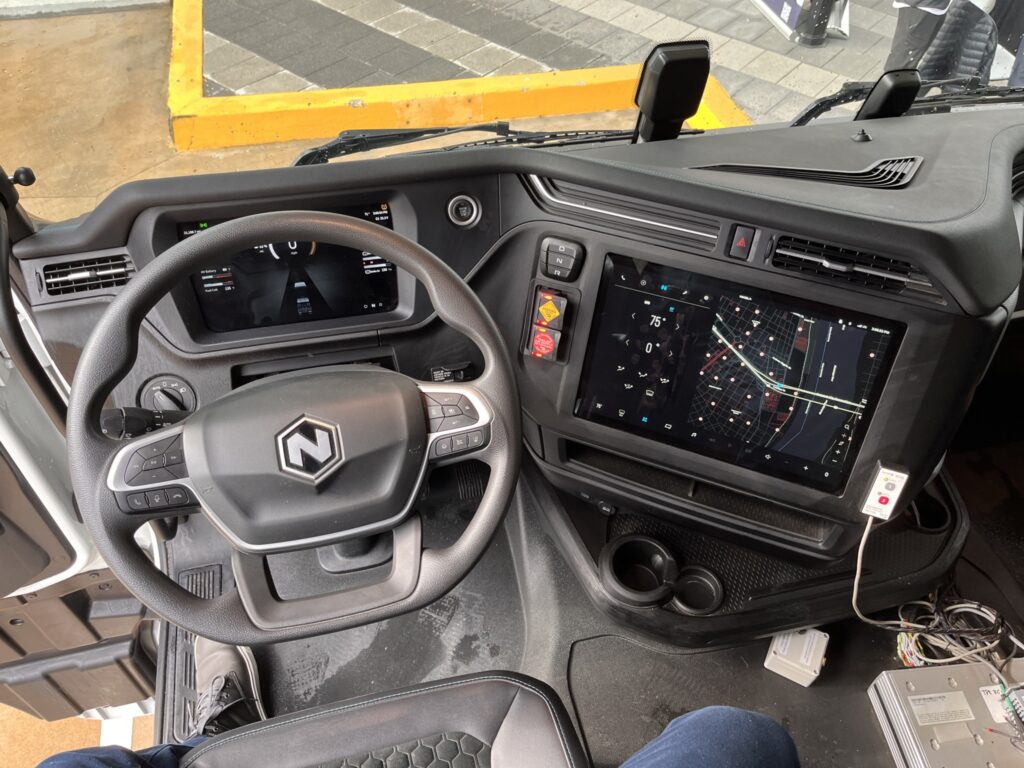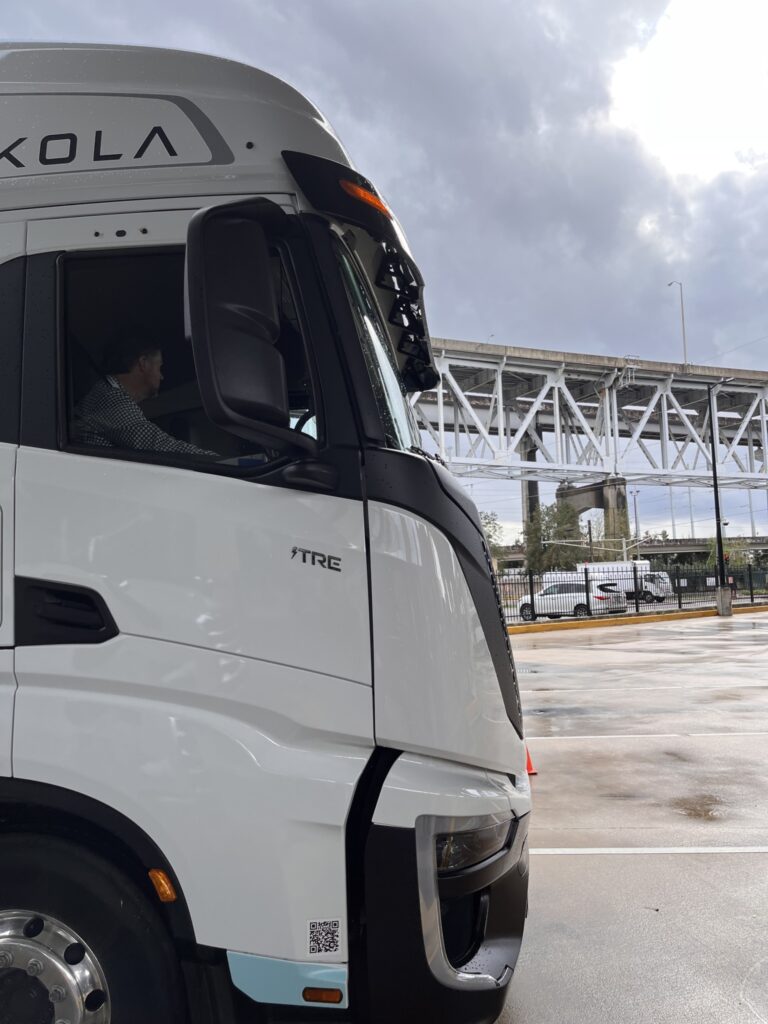Nikola’s fuel-cell-electric Tre designed for the long haul
Nikola’s big bold cabover truck has become the poster child for electric trucks. You see it in all kinds of videos and print stories about the transition from diesel. It stands out from the crowd because it’s a cabover engine (COE) design. But that’s just the beginning of the story.
The battery-electric version of the Tre model has been on the streets for more than a year now. The fuel-cell version left the stable late last year. Nikola says it has produced 42 to date and delivered 35 to dealers. One is currently under evaluation in Alberta and has successfully made return trips between Edmonton and Calgary without a refueling stop.

There have been a few setbacks with the Tre, including several recalls and of course the battery fires. Nikola has switched battery suppliers and says it’s on track to deliver the first re-worked trucks with new battery packs to end users by spring.
Time will tell how the company responds to those challenges, but assuming they are successful, I think Nikola will be in the game for the longhaul. Pun intended.
I drove the fuel-cell version of the Tre during the Technology & Maintenance Council’s annual general meeting in New Orleans in early March. The ride was literally a trip around the block, twice. Only about five miles, but the drive offered an opportunity to compare the battery and the fuel-cell version.
Hint: The fuel-cell version is still an electric drive truck. The motors are fed electrons from batteries, just like the battery truck. The only difference is the energy storage medium.

How fuel cells work
Fuel cells convert hydrogen gas to electricity. The process is too complex process to explain here, but it’s essentially the opposite process from one of the ways of producing hydrogen: electrolysis — where ordinary water is split into its component molecules, oxygen and hydrogen. Essentially, a fuel cell generates electricity by recombining hydrogen and oxygen.
In a truck, the fuel cell generates the electricity to charge a battery. The battery powers the motor; the truck doesn’t run directly on hydrogen.
The fuel cell draws hydrogen gas from the storage tanks at a pretty steady rate depending on the demand. The process is independent of the throttle pedal and the driver’s control. The battery responds to power demand from the throttle pedal, while the fuel cell operates at an output rate that will keep the batteries at a 75% (or so) state of charge most of the time.
Starting the truck is really just turning it on and activating all the systems. There’s nothing to start in the conventional sense. It can take a few minutes for the fuel cell to begin producing electricity when the truck is “cold and dark” on the first shift of the day. The driver gets a “ready” indicator in the display, after which you can drop it into gear and drive away.
The only sound you hear are the fans for fuel cell air intake and cooling. These are no noisier than a typical HVAC fan at low-medium speed. Nothing to complain about.
Since the truck is driven by the battery — not the fuel cell directly — it can operate solely on battery if the fuel cell should quit, or the hydrogen tanks run dry. Who hasn’t run out of fuel at least once in their career?
Depending on the battery state of charge, you may get 50-75 miles before the battery is depleted too. The energy monitoring system is set up to optimize charging over power output when the hydrogen storage level gets low so the truck will have maximum range on the remaining battery charge.
The battery electric version has nine battery modules for a total of 733 kw/h of storage, while the fuel cell version has just two totaling 164 kw/h.

Ride and handling
If you’ve heard stories from old-timers with serious miles on old-style North American COE trucks, ignore them. The Tre, built on a European Iveco S-Way platform, rides like a luxury motor coach. Any resemblance to our old COE trucks ends at the front bumper.
The truck is heavy, as all electric trucks are. I was told by a prospective Nikola Tre BEV customer the weight was close to 29,000 lb. I later confirmed that with Nikola. The weight of the fuel-cell version is said to be similar, but I couldn’t confirm the actual weight. That said, the truck rides on a steer axle with a 17,200-lb. taper-leaf suspension. It rides on 315/80R22.5 tires, which are motor coach tires to accommodate the weight.
The driver’s seat is actually out in front of the steer axle, with gives an odd sensation when turning. However, the ride is remarkably smooth. Like, 240-in wheelbase longnose conventional smooth. Probably better, actually.
And it’s wicked maneuverable. With a wheelbase of 182 inches and a very tight cut to the steering wheels, it will turn a full circle in less than 25 feet. It’s a brilliant design for maneuvering in close quarters.
A short part of the route we took was over cobblestones. While it was rough, there were no shocks or jolts from the suspension. Here, the weight worked to our advantage, but the super-smooth suspension, underneath the cab air suspension and the air-ride seat, made quick work of those cobblestones.
The throttle pedal — what else can I call it … the rheostat? — is calibrated to provide a decent range of movement so drivers can be articulate in their speed choice. It doesn’t creep, which is to say, if you want it to move forward or backward you have to apply some throttle. Even bobtailing around town, it was easy to keep the truck at 20-25 mph.
The regenerative braking mode was a bit more aggressive, but I was in the high position. I found taking my foot right off the throttle pedal produced solid and sudden deceleration. However, easing my right foot off the throttle allowed me to modulate the deceleration as if I was using the brake pedal.
Drivers are going to love this, I’m sure. You’ve probably heard the term ‘one-pedal driving?’ With a bit of finesse, drivers can accelerate and decelerate the truck using just the throttle pedal and the regenerative braking effect.

Driver environment
The cab floor is nearly five feet off the ground, and the roof stands a little more than 13 feet high. Standing up inside the cab, there was still nearly two feet between my head and the ceiling.
While the truck is billed as a day cab, it does have a 24-inch area behind the seats that, in the European version of the Iveco S-way, is the sleeper. It could be used as a sleeper, but mostly for naps. Nikola says it’s developing a sleeper version of the fuel cell truck for longhaul service.
The dashboard A-panel has a small display with all the essential information, such as road speed, battery state of charge, hydrogen quantity remaining, etc., as well as brake system air pressure, fuel cell temp and such.
The B-panel is dominated by a massive display that includes a GPS navigation screen, trip details, and loads of other detail the further you drill down. It also includes a complete diagnostics interface that shows fault codes in plain English as well as detailed instructions for certain procedures, such as how to fill coolant tanks or degassing the system prior to servicing the truck. That was developed in-house so it’s unique to Nikola, and it’s all at the driver’s fingertips.
The visibility is fantastic, thanks to the huge windshield and the absence of a hood. The mirrors are huge, and the side windows are cut pretty deeply into the doors. That vast expanse of glass offers the best view of the outside world of any truck on the road today, bar none.
And of course it’s quiet. There’s no diesel roaring away under the cab for starters. And when it’s rolling, the gear and motor noise I’ve heard on some electric trucks is gone. It’s eerily quiet, actually. You can play the radio at a reasonable volume and have a conversation without shouting.
Final thoughts
I had about 30 minutes with the truck to take photos and ask questions and take it for a quick spin. We never got over 30 mph riding around downtown New Orleans, so I can’t offer and opinion on how it handled in crosswinds or how fast it walked up a 6% grade — not that you find one of those within 500 miles of New Orleans.
I don’t think too many fleets will buy this truck just because it’s a COE, but that niche will elevate its profile quite a bit. Plus, drivers will be pretty keen on driving one — some for the novelty of driving a COE, others because it so smooth, comfortable and quiet.

Have your say
This is a moderated forum. Comments will no longer be published unless they are accompanied by a first and last name and a verifiable email address. (Today's Trucking will not publish or share the email address.) Profane language and content deemed to be libelous, racist, or threatening in nature will not be published under any circumstances.
So I’m not sure why you didn’t cover the most important parts of the conversation that is, how much Torque does the unit produce along with mileage per fill up ? Also , has the truck been tested pulling 80k across roads, terrain , etc to measure the power and distance it produces pulling such weight? Those aren’t concerns and I should think any trucking company’s target concerns along with maint costs, in order to gauge this technology against current business metrics? What am I missing in this ??? Thanks , current CDL over the road professional
I would be curious to know about crash testing safety data. 2. Ride at 65 mph on highways like 11 in Ohio or 17 in N.Y. 3. Gross weight Payload capability for heavy haul applications on various grades. 4. What everyone is talking about, extreme cold condition performance. 5. Infrastructure and support. Overall, I think this is happening but when on a large scale is anyones guess.